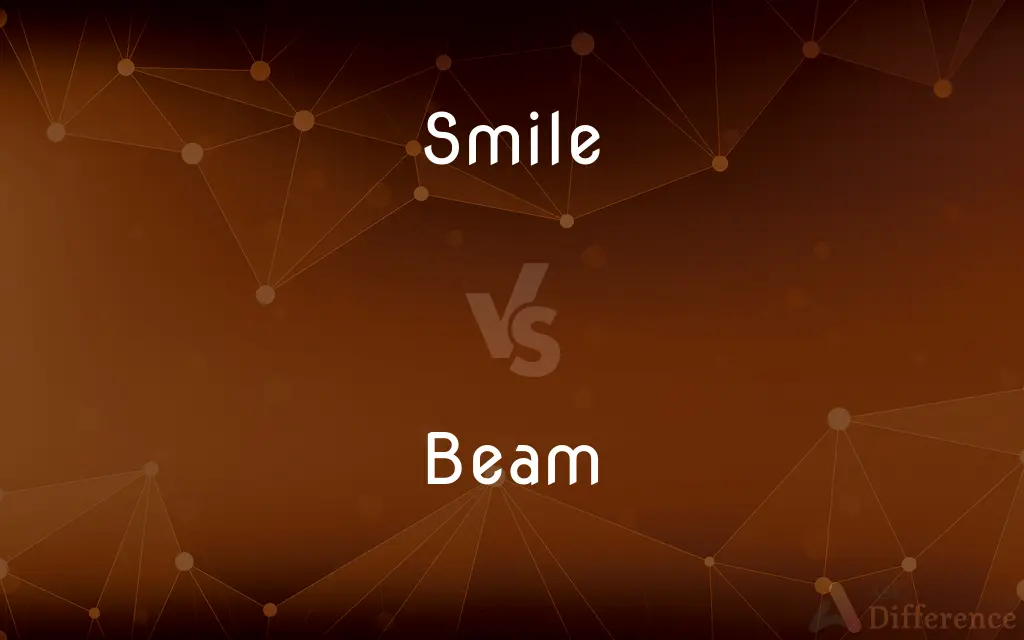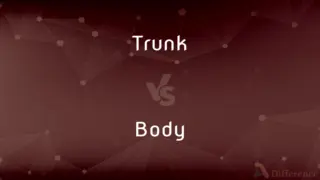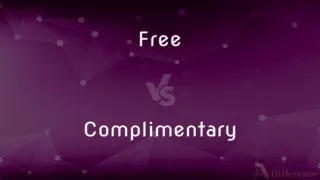Smile vs. Beam — What's the Difference?
By Tayyaba Rehman & Fiza Rafique — Updated on April 20, 2024
Smile often signifies a gentle, pleasant expression using the mouth, while a beam is a broader, more intense smile involving the eyes.

Difference Between Smile and Beam
Table of Contents
ADVERTISEMENT
Key Differences
A smile is typically a subtle expression, often used to convey mild pleasure or sociability, and involves the upward curving of the corners of the mouth. Whereas, a beam is a type of smile that is much more pronounced and radiates happiness, often described as beaming from ear to ear, suggesting a greater level of joy or enthusiasm.
When someone smiles, it can be a polite gesture or a signal of contentment, and it might not engage the entire face. On the other hand, beaming is a more overt expression that typically involves both the mouth and the eyes, emphasizing a stronger, more genuine emotional response.
Smiling can be social and does not necessarily reflect genuine happiness; it can be controlled and subtle. Conversely, beaming is almost always a spontaneous reaction to something extremely positive and is hard to fake.
In social contexts, a smile is often expected as a common courtesy, making it a social norm in many cultures. However, a beam is usually reserved for situations of genuine delight or excitement, making it less common but more impactful when it occurs.
The physiological impact of smiling can boost the mood slightly by releasing endorphins. Meanwhile, the act of beaming can create a more significant increase in endorphins, leading to a greater feeling of joy and even affecting those around the beamer positively.
ADVERTISEMENT
Comparison Chart
Definition
A mild, polite expression
A broad, intense expression of joy
Facial Involvement
Mainly the mouth
Mouth and eyes prominently
Emotional Intensity
Generally low to moderate
High
Social Usage
Common in formal settings
Seen in genuinely joyful moments
Authenticity
Can be polite or genuine
Generally indicates genuine happiness
Compare with Definitions
Smile
In photography, a smile is often requested to create a pleasant appearance.
The photographer asked everyone to smile for the group photo.
Beam
A radiant or broad smile involving the eyes, indicating joy.
Her face beamed with pride at her graduation.
Smile
A facial expression characterized by turning up the corners of the mouth; usually shows happiness or amusement.
She gave a small smile in response to the compliment.
Beam
Beaming can indicate a high degree of pleasure or satisfaction.
The child beamed after receiving the gift.
Smile
An expression of contentment or amusement that does not involve the eyes.
His polite smile didn't reach his eyes.
Beam
To emit a bright and joyous expression often associated with pride or excitement.
He beamed at the good news.
Smile
Smiles can be ambiguous and hide one's true feelings.
She maintained a smile even though she was feeling upset.
Beam
In storytelling, characters often beam to express overt happiness.
The hero beamed as he was cheered by the crowd.
Smile
A smile can also be used to convey comfort or to reassure.
He smiled at the nervous passenger beside him.
Beam
A beam is less likely to be misunderstood and is clearly positive.
Her beaming smile lit up the room.
Smile
A smile is formed primarily by flexing the muscles at the sides of the mouth. Some smiles include a contraction of the muscles at the corner of the eyes, an action known as a Duchenne smile.
Beam
A long, sturdy piece of squared timber or metal used to support the roof or floor of a building
There are very fine oak beams in the oldest part of the house
The cottage boasts a wealth of exposed beams
Smile
A facial expression characterized by an upward curving of the corners of the mouth and indicating pleasure, amusement, or derision.
Beam
A ray or shaft of light
A beam of light flashed in front of her
The torch beam dimmed perceptibly
Smile
To have or form a smile.
Beam
A radiant or good-natured look or smile
A beam of satisfaction
Smile
To look with favor or approval
Fortune smiled on our efforts.
Beam
Transmit (a radio signal or broadcast) in a specified direction
The satellite beamed back radio signals to scientists on Earth
Smile
To express cheerful acceptance or equanimity
We smiled at the bad weather and kept going.
Beam
(of a light or light source) shine brightly
The sun's rays beamed down
Smile
To express with a smile
Grandmother smiled her consent.
Beam
Smile radiantly
She beamed with pleasure
Smile
A facial expression comprised by flexing the muscles of both ends of one's mouth, often showing the front teeth, without vocalisation, and in humans is a common involuntary or voluntary expression of happiness, pleasure, amusement, goodwill, or anxiety.
She's got a perfect smile.
He has a sinister smile.
She had a smile on her face.
He always puts a smile on my face.
Beam
A squared-off log or a large, oblong piece of timber, metal, or stone used especially as a horizontal support in construction.
Smile
(figurative) Favour; propitious regard.
The smile of the gods
Beam
A transverse structural member of a ship's frame, used to support a deck and to brace the sides against stress.
Smile
A drink bought by one person for another.
Beam
The breadth of a ship at the widest point.
Smile
(ambitransitive) To have (a smile) on one's face.
When you smile, the whole world smiles with you.
I don't know what he's smiling about.
She smiles a beautiful smile.
Beam
The side of a ship
Sighted land off the starboard beam.
Smile
(transitive) To express by smiling.
To smile consent, or a welcome
Beam
(Informal) The widest part of a person's hips
Broad in the beam.
Smile
(intransitive) To express amusement, pleasure, or love and kindness.
Beam
A steel tube or wooden roller on which the warp is wound in a loom.
Smile
(intransitive) To look cheerful and joyous; to have an appearance suited to excite joy.
The sun smiled down from a clear summer sky.
Beam
An oscillating lever connected to an engine piston rod and used to transmit power to the crankshaft.
Smile
(intransitive) To be propitious or favourable; to countenance.
The gods smiled on his labours.
Beam
The bar of a balance from which weighing pans are suspended.
Smile
To express amusement, pleasure, moderate joy, or love and kindness, by the features of the face; to laugh silently.
He doth nothing but frown. . . . He hears merry tales and smiles not.
She smiled to see the doughty hero slain.
When last I saw thy young blue eyes, they smiled.
Beam
(Sports) A balance beam.
Smile
To express slight contempt by a look implying sarcasm or pity; to sneer.
'T was what I said to Craggs and Child,Who praised my modesty, and smiled.
Beam
The main horizontal bar on a plow to which the share, coulter, and handles are attached.
Smile
To look gay and joyous; to have an appearance suited to excite joy; as, smiling spring; smiling plenty.
The desert smiled,And paradise was opened in the wild.
Beam
One of the main stems of a deer's antlers.
Smile
To be propitious or favorable; to favor; to countenance; - often with on; as, to smile on one's labors.
Beam
A ray or shaft of light.
Smile
To express by a smile; as, to smile consent; to smile a welcome to visitors.
Beam
A concentrated stream of particles or a similar propagation of waves
A beam of protons.
A beam of light.
Smile
To affect in a certain way with a smile.
And sharply smile prevailing folly dead.
Beam
A radio beam.
Smile
The act of smiling; a peculiar change or brightening of the face, which expresses pleasure, moderate joy, mirth, approbation, or kindness; - opposed to frown.
Sweet intercourseOf looks and smiles: for smiles from reason flow.
Beam
To radiate light; shine.
Smile
A somewhat similar expression of countenance, indicative of satisfaction combined with malevolent feelings, as contempt, scorn, etc; as, a scornful smile.
Beam
To smile expansively.
Smile
Favor; countenance; propitiousness; as, the smiles of Providence.
Beam
To emit or transmit
Beam a message via satellite.
Smile
Gay or joyous appearance; as, the smiles of spring.
The brightness of their [the flowers'] smile was gone.
Beam
To express by means of a radiant smile
He beamed his approval of the new idea.
Smile
A facial expression characterized by turning up the corners of the mouth; usually shows pleasure or amusement
Beam
Any large piece of timber or iron long in proportion to its thickness, and prepared for use.
Smile
Change one's facial expression by spreading the lips, often to signal pleasure
Beam
One of the principal horizontal structural members, usually of steel, timber, or concrete, of a building; one of the transverse members of a ship's frame on which the decks are laid — supported at the sides by knees in wooden ships and by stringers in steel ones.
Smile
Express with a smile;
She smiled her thanks
Beam
(nautical) The maximum width of a vessel (note that a vessel with a beam of 15 foot can also be said to be 15 foot abeam).
This ship has more beam than that one.
Beam
(nautical) The direction across a vessel, perpendicular to fore-and-aft.
Beam
The crossbar of a mechanical balance, from the ends of which the scales are suspended.
Beam
The principal stem of the antler of a deer.
Beam
(literary) The pole of a carriage or chariot.
Beam
(textiles) A cylinder of wood, making part of a loom, on which weavers wind the warp before weaving and the cylinder on which the cloth is rolled, as it is woven.
Beam
The straight part or shank of an anchor.
Beam
The central bar of a plow, to which the handles and colter are secured, and to the end of which are attached the oxen or horses that draw it.
Beam
In steam engines, a heavy iron lever having an oscillating motion on a central axis, one end of which is connected with the piston rod from which it receives motion, and the other with the crank of the wheel shaft.
Beam
A ray or collection of approximately parallel rays emitted from the sun or other luminous body.
A beam of light
A beam of energy
Beam
(figuratively) A ray; a gleam.
A beam of hope, or of comfort
Beam
One of the long feathers in the wing of a hawk.
Beam
(music) A horizontal bar which connects the stems of two or more notes to group them and to indicate metric value.
Beam
(railway) An elevated rectangular dirt pile used to cheaply build an elevated portion of a railway.
Beam
(gymnastics) balance beam
Beam
(ambitransitive) To emit beams of light; to shine; to radiate.
To beam forth light
Beam
To smile broadly or especially cheerfully.
Beam
(transitive) To furnish or supply with beams.
Beam
(transitive) To give the appearance of beams to.
Beam
To transmit matter or information via a high-tech wireless mechanism.
Beam me up, Scotty; there's no intelligent life down here.
The injured crewmembers were immediately beamed to sickbay.
Beam
To transmit, especially by direct wireless means such as infrared.
Beam
To stretch something (for example, an animal hide) on a beam.
Beam
To put (something) on a beam.
Beam
To connect (musical notes) with a beam, or thick line, in music notation.
Beam
Any large piece of timber or iron long in proportion to its thickness, and prepared for use.
Beam
One of the principal horizontal timbers of a building or ship.
The beams of a vessel are strong pieces of timber stretching across from side to side to support the decks.
Beam
The width of a vessel; as, one vessel is said to have more beam than another.
Beam
The bar of a balance, from the ends of which the scales are suspended.
The doubtful beam long nods from side to side.
Beam
The principal stem or horn of a stag or other deer, which bears the antlers, or branches.
Beam
The pole of a carriage.
Beam
A cylinder of wood, making part of a loom, on which weavers wind the warp before weaving; also, the cylinder on which the cloth is rolled, as it is woven; one being called the fore beam, the other the back beam.
Beam
The straight part or shank of an anchor.
Beam
The main part of a plow, to which the handles and colter are secured, and to the end of which are attached the oxen or horses that draw it.
Beam
A heavy iron lever having an oscillating motion on a central axis, one end of which is connected with the piston rod from which it receives motion, and the other with the crank of the wheel shaft; - called also working beam or walking beam.
Beam
A ray or collection of parallel rays emitted from the sun or other luminous body; as, a beam of light, or of heat.
How far that little candle throws his beams!
Beam
A ray; a gleam; as, a beam of comfort.
Mercy with her genial beam.
Beam
One of the long feathers in the wing of a hawk; - called also beam feather.
Beam
To send forth; to emit; - followed ordinarily by forth; as, to beam forth light.
Beam
To emit beams of light.
He beamed, the daystar of the rising age.
Beam
A signal transmitted along a narrow path; guides pilots in darkness or bad weather
Beam
Long thick piece of wood or metal or concrete, etc., used in construction
Beam
A column of light (as from a beacon)
Beam
A group of nearly parallel lines of electromagnetic radiation
Beam
(nautical) breadth amidships
Beam
A gymnastic apparatus used by women gymnasts
Beam
Smile radiantly; express joy through one's facial expression
Beam
Emit light; be bright, as of the sun or a light;
The sun shone bright that day
The fire beamed on their faces
Beam
Express with a beaming face or smile;
He beamed his approval
Beam
Broadcast over the airwaves, as in radio or television;
We cannot air this X-rated song
Beam
Especially of the complexion: show a strong bright color, such as red or pink;
Her face glowed when she came out of the sauna
Beam
Experience a feeling of well-being or happiness, as from good health or an intense emotion;
She was beaming with joy
Her face radiated with happiness
Common Curiosities
Can smiling too much have a negative effect?
Yes, excessive or insincere smiling can sometimes be perceived as ingratiating or dishonest.
Are smiles universal in their meaning?
While smiling is generally associated with happiness, its interpretation can vary across different cultures.
Can a smile or a beam affect one's health?
Yes, both smiling and beaming can have positive health effects, such as reducing stress levels, lowering blood pressure, and boosting the immune system.
Is there a difference in how often men and women beam?
Research suggests that women may smile and beam more frequently than men, possibly due to social and cultural factors that encourage women to express emotions more openly.
What psychological effects does beaming have?
Beaming can significantly boost the mood of both the beamer and the observers, enhancing feelings of happiness and connectedness.
What are some common situations where people are more likely to beam than smile?
People are more likely to beam during moments of personal achievement, joyful reunions, or when receiving exceptionally good news, as these situations elicit stronger emotional responses.
How is beaming perceived in professional settings?
In professional settings, beaming is generally perceived positively as it conveys enthusiasm and confidence. However, the context and culture of the workplace can influence how such expressions are viewed.
Is it possible to fake a beam like a smile?
It's harder to fake a beam because it involves more intense facial expressions and genuine emotion.
How do children learn to smile and beam?
Children learn to smile from as early as infancy, and beaming as they grow and understand social cues and expressions of joy.
Can animals smile or beam like humans?
While animals may display behaviors that look like smiling or beaming, these expressions are not necessarily linked to emotions as they are in humans. In animals, such expressions are often related to different social signals.
Share Your Discovery

Previous Comparison
Trunk vs. Body
Next Comparison
Free vs. ComplimentaryAuthor Spotlight
Written by
Tayyaba RehmanTayyaba Rehman is a distinguished writer, currently serving as a primary contributor to askdifference.com. As a researcher in semantics and etymology, Tayyaba's passion for the complexity of languages and their distinctions has found a perfect home on the platform. Tayyaba delves into the intricacies of language, distinguishing between commonly confused words and phrases, thereby providing clarity for readers worldwide.
Co-written by
Fiza RafiqueFiza Rafique is a skilled content writer at AskDifference.com, where she meticulously refines and enhances written pieces. Drawing from her vast editorial expertise, Fiza ensures clarity, accuracy, and precision in every article. Passionate about language, she continually seeks to elevate the quality of content for readers worldwide.
















































